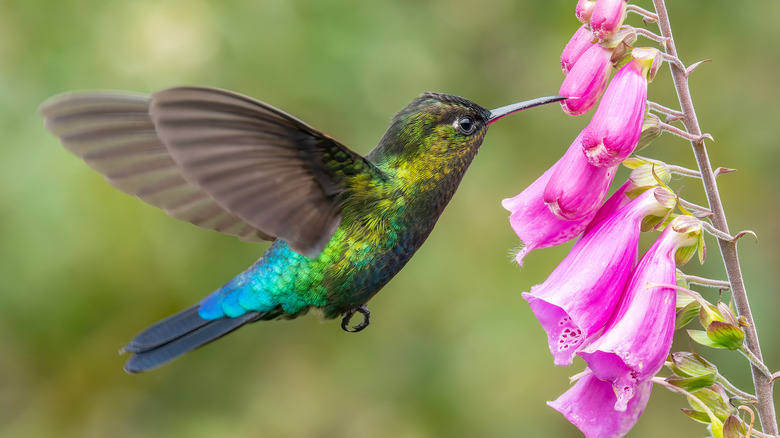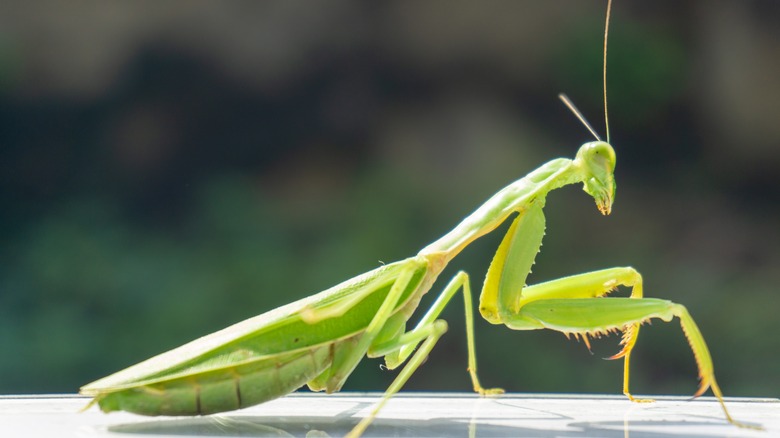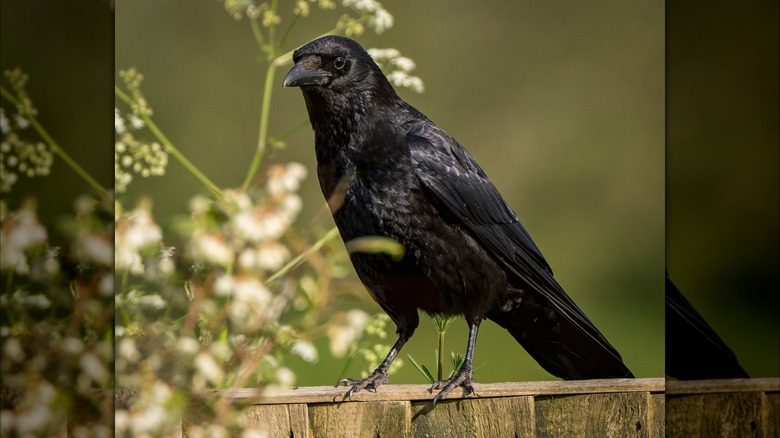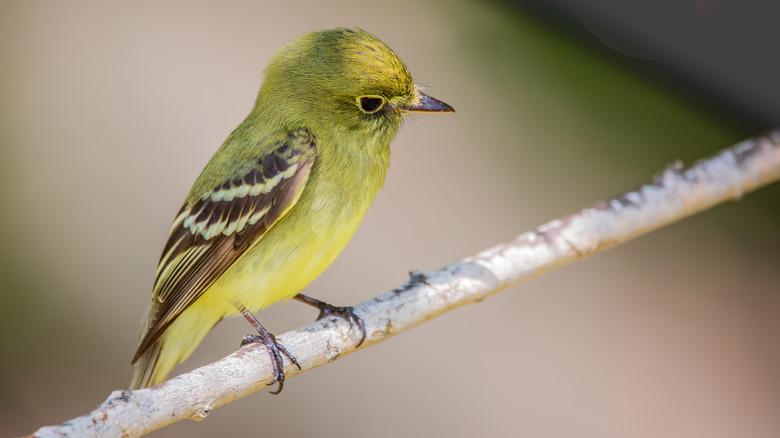17 Predators That Could Be Eating Hummingbirds In Your Yard & Garden
Hummingbirds are undoubtedly fascinating. Whether they're unleashing their fury on comrades, predators, or even gardeners for daring to wade into their territory, slurping sweet nectar from flowers and bird stations, or speeding through the garden, they're unrivaled stars that invoke our protective instincts through and through. Yet, that's not always how nature works, as there is a food web in place, and it demands to be followed. Not to mention, all that wayfaring through ever-changing weather, scarce food resources, window collisions, and cat predation take a toll. Indeed, according to the American Bird Conservancy, no more than 42% and 31% of female and male ruby-throated hummers respectively survive past their birth year.
While hummers are amply blessed with speed and fervor, they are still picked off by diverse interlopers who can afford to keep up or encounter them by accident or smarts. And no, we aren't referring to a swarm of ants, wasps, or bees, who sting the hover birds in the name of colony protection, although they sure do count as pests you don't want anywhere near your feeders. Nor are we alluding to their unfortunate liaison with purple burdock flowers whose lively hooks ensnare the hummingbirds, leaving them lifeless. Instead, this fight club includes the likes of jays, dragonflies, and more, as you'll find below. While it's best to let nature take its course, take precautions if the idea of your yard turning into a hummingbird battleground makes you squeamish.
1. Praying mantises
Seeing a praying mantis on your hummingbird feeder is concerning. According to a 2017 study published in The Wilson Journal of Ornithology, only 2 percent of hummingbirds captured by mantises were able to escape on their own. When famished, mantids' eyes bulge, making tiny avians, especially ruby-throated hummingbirds seem easy prey. The invasive Chinese mantis is notorious for unfolding its spiked forelegs to pierce into hummers' skulls and eat them alive. Bird-eating mantises exist on every continent, so if you see one stalking a bird feeder, flick off the puny mantid and move the feeder elsewhere away from the verdant shrubbery.
2. Blue jays
While you might be part of the tribe of homeowners who use birdscaping tips to turn your yard and garden into a bird haven, you probably didn't realize that certain birds share an uneasy relationship, such as blue jays and hummingbirds. The raucous songsters are often found racing and sometimes nabbing the hovering birds after they're done drinking from the bird baths. Despite their unceasing affection for acorns, the blue-plumed birds have been established to make a meal of hummers' eggs and chicks, leaving the mothers despondent and raising the necessity to cover feeders and nests with protective netting.
3. Cats
Having jawed over 2.4 billion birds annually (per American Bird Conservancy), it's unsurprising that cats are considered the most deadly hummingbird predators, regardless of whether they live mostly in your house or roam with impunity on the streets. The story of one species of Chilean hummingbird, the Juan Fernández Firecrown, is proof of the danger cats pose. Since cats were introduced to their environment, they have reached critically endangered status (both eggs and adults are devoured by feral cats). So, before your beloved pets make a sport of hummers, keep them indoors. Also, hang the hummingbird feeders 8 feet high out of their paws' reach.
4. Hawks
This might come as a shocker as hawks in your yard are a good sign for hummingbirds — for the most part — especially for nesting hummers. That's because building their homes underneath a hawk's creates a living, conical defense wall against blue jays without any adverse ramifications for large-sized hawks, like red-tailed hawks don't consider them a good meal. However, small-bodied hawks, including sharp-shinned and Cooper's consider hummingbirds worth the chase, most certainly when they're on and about feeders having their fill of sugar water for fall migration. Move the feeders indoors for a bit until the danger is past.
5. Snakes
Although more common in the Neotropics, a few US citizens have had to live through the sight of snakes coiling around the hummingbird feeder, flicking and gobbling up the ruby-throated in minutes. Not only that, the younglings of Black and Gray rat snakes are known for ferreting out and dining on hummer's eggs or the hatched brood. To keep the feathered visitors safe, capture the snakes to remove them to a different location, far from your yard. Also, consider taking down the feeders or moving them to a different location at a considerable distance from the slither's haunts.
6. Crows and ravens
Right up with the boisterous blue jays, the cacophonous cawing crows and ravens have exhibited tendencies of expanding their palates from earthworms, seeds, insects, and carrion to bean-sized eggs of black-chinned hummingbirds. Despite no love for birdfeeders, they will shadow the zippy avians that do in hopes of chancing upon and chomping down on their offspring, proving the allure for hummers runs strong in the Corvus genus. If hummingbirds have picked raptors' hunting grounds as nesting territory, this will keep the crafty crows out. Otherwise, you might have to harass the birds back by playing distress calls.
7. Frogs
If you have a wildlife pond or a water garden, live close to a lake, or have recently experienced a rain spell, the unsuspecting hummingbirds in your yard may be at risk of falling prey to a frog's mandibles. There are anecdotes galore about bullfrogs, leopard frogs, and green frogs perfunctorily pouncing on rufous, and ruby-throated hummers and dashing off into the marshy vegetation to wolf them down in peace. You might even find a few hanging out by a feeder pole — just lead them back to the pond and, if possible, provide an alternate water source to your thirsty hummingbirds.
8. Greater Roadrunners
One would reckon with limbs well served to run rather than flap, greater roadrunners would be better off pursuing rodents, centipedes, rattlesnakes, and lizards, or even nibbling through cactus fruit when insects are scarce in their southwest desert habitat. Yet, when an iridescent-feathered hummer catches their fancy, they're quick to leap off the ground to snag the prize. Worse, roadrunners dispatch their prey by bashing their heads into the ground and swallowing their lifeless bodies — truly a disturbing sight, although it would be punctuated by vivid red and white bands revealed in the triumphant bird's head.
9. Falcons
With concerns being raised about the declining population of various birds of prey, including American Kestrels, small red and gray falcons, some owners have taken to putting up nest boxes in their yards to reverse their misfortunes. However, these pole and tree sitters can attack hummingbirds when their hunt for insects proves futile. Similarly, Merlins, another nest-stealing little falcon, have indulged in similar hummer-eating activities. If the problem becomes acute, encase the bird feeders in an enclosure or move them underneath an awning, eaves, or tall trees to give the feathered jewels essential escape cover.
10. Orb-weaver Spiders
Disposed to treating everything in nature as free-for-all, hummingbirds have no qualms about robbing spiders of their webs to plait their own nests. That is unless the spider silk ensnares them instead, entombing them eternally, ripe for the weaver's absorption. Garden spiders may even deliberately lurk around hummingbird feeders to entice them with their silk, as an Illinois-based couple discovered. While there's no stopping hummers from walking into a webby trap — their progeny needs a home — you can rescue them by peeling off the net and leading them to a source of nectar.
11. Robber Flies
House flies' much bigger and carnivorous cousins, robber flies, have ratcheted up infamy for mimicking bees (whose cadavers you might often find under the insects' perches) and deluding gardeners into thinking they're helping out pollinators. They rock the boat further through their brazen disregard for all food chain etiquette, as they knife into targets twice their size, such as hummingbirds, stilling them with their venom and spindly leggy holds. The meal is finished back at their throne. Though you might want nothing to do with robber flies to avoid any freak accidents, they're labeled beneficial for eating arthropods.
12. Dragonflies
Once folklore until it wasn't, dragonflies love punching above their weight class. Dragon hunters — who in their name's vein hunt their ilk — and common green darners have been reported in some papers and recently in a photograph, to overpower hummingbirds. But considering most dragonflies feed on mosquitoes, aphids, and termites, thus doing gardeners a huge service, you shouldn't be clambering to banish them from your yard. That being said, it doesn't hurt to keep large dragonflies away from your hummingbird feeders.
13. Loggerhead Shrikes
When you were going to the moon and back to transform your yard into a songbird haven, you possibly weren't thinking of Loggerhead shrikes. Sometimes mistaken for American kestrels, as they too prefer hovering high in the sky like drones singling out their kill, loggerhead shrikes are some of the grisliest songbirds. They jab their hooked bill into their prey to paralyze them and then cruelly impale the carcasses on sharp objects. From monarch butterflies and grasshoppers, they switch to hummingbirds in a pinch.
14. Squirrels and chipmunks
If you're sick of going ballistic at squirrels for raiding your bird feeders, uprooting your lilies, or hollowing out the soil to hide their acorns, know there's another crime you can potentially charge them with: troubling hummingbirds. Even though hummers are cautious about choosing tree limbs that aren't sturdy enough to support the bushy-tailed fiends, it doesn't always come to pass. This means mammals like Eastern gray squirrels and Eastern chipmunks can turn their chicks or eggs into early dinners. Consider adding motion sprinklers to keep squirrels from even thinking about your yard.
15. Owls
To survive the bitterly cold weather, hummers often resort to torpor (their version of hibernation) wherein they vastly reduce their energy needs and body temperature. Smart owls capitalize on this trait, lifting the flying jewels during their nocturnal or dawn hunts. There are also anecdotal episodes of owls feeding hummingbirds to their newly hatched fledglings during the nesting season. If you notice the night hunters eyeballing your hummingbirds, place a "hawk globe" in their flight corridor. As these globes behave like mirrors, owls mistake their reflection for a fellow predator and steer clear of the territory being the loners they are.
16. Grackles
Love them or hate them, grackles are here to stay. Having embraced urbanized cities like no other, grackles create quite the mess in yards when they chuck birdseed on the ground, rage at their counterparts, or intercept hummingbirds when they're on their merry way, albeit rarely. To prevent grackles from going after hummers, consider spreading some grains or corn on the ground so that they pay no heed to feeding stations. You may also consider removing perches from hummingbird feeders to impede the grackles' access.
17. Flycatchers
A short-distance nomad, brown-crested flycatchers are late-spring harbingers who nest in parts of the southwest US so long as they can find trees with large cavities. Although most of their diet consists of cicadas, dragonflies, lizards, and grasshoppers — pests most gardeners wouldn't mind being consumed — these high flyers can be found stalking hummingbirds from their tree sit-spots and descending on them in a flash for a quick bite. There are similar stories of sage and juniper-loving gray flycatchers eating hummingbirds after treating them to a gruesome bashing as they would do to large insects.

















